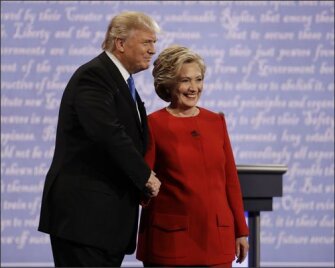
The resegregation of the nation’s schools might be one of the hottest issues in education policy these days. But it’s never really penetrated the presidential race.
So, now that the race is almost at the finish line: What have Democratic president nominee Hillary Clinton and GOP nominee Donald Trump said about school integration? Why hasn’t there been more talk about it? And maybe, more importantly, what, if anything, can the next president do to help schools become more racially and socio-economically diverse?
Campaign Rhetoric
Let’s start with the first question, what has actually been said. Clinton hasn’t given a major speech focused only on this topic, but she has addressed it on the campaign trail, to some extent.
For instance, in a speech in May to the NAACP, Clinton noted that, “Our schools are more segregated than they were in 1968. We’ve got to reverse that. It’s dangerous. We need a good school with a good teacher in the classroom for every child no matter [where] that child lives.”
And in late September, on the anniversary of the integration of Central High School in Little Rock, Ark., Clinton also sent

a personally signed tweet saying that the country needed to finish the work of the nine black students who became the first students of color to attend the school, over the strenuous objections of the state and many white residents.
Maybe more prominently, her running mate, Tim Kaine and his wife, Anne Holton, have talked quite a bit about the issue. Holton’s father, A. Linwood Holton, lead the effort to desegregate the Richmond, Va., schools in the early 1970s, as governor of the state. Holton herself attended one of those integrated schools, and later, she and Kaine sent her own children to them.
It was a good experience, for all of them, Holton said in an interview.
“As a 12-year-old, to have an opportunity to be part of something larger than yourself that advances the ball for the world, was a very special opportunity,” she explained. And her own kids were exposed to life experiences that those who attended more homogenous schools did not have.
The next president can move the needle on reducing school resegregation first and foremost by talking about it, Holton said.
“I think there is a federal role, starting with the bully pulpit,” she said. “And we’re doing that right now by talking about it.”
It’s unclear exactly what steps a Clinton administration might take beyond the bully pulpit, though. Clinton has floated some proposals that Holton said would address inequities, including anti-poverty measures such as raising the minimum wage, and dramatically expanding access to early-childhood education. But she hasn’t put forth a specific proposal focused just on school integration.
The Trump campaign did not return calls for this story. The centerpiece of Trump’s education plan is a serious expansion of school choice, which he said would help students who are stuck in “failing” schools in “inner cities.” The program would allocate $20 billion in federal funding to allow students to attend any private or public school of their choice. Trump didn’t explicitly couch his plan as a way for schools to become more racially or socioeconomically integrated.
Trump also has said that Democrats have taken black and Hispanic voters for granted, in part through perpetuating educational inequality, and he has urged them to support him instead. “You’re living in poverty, your schools are no good, you have no jobs, 58 percent of your youth is unemployed—what the hell do you have to lose?” Trump said at a rally in August.
What Can the Feds Do?
Why hasn’t there been more specific discussion of these issues on the campaign trail?
The campaign hasn’t really been about policy of any kind, whether it’s energy or equity in education, said Gary Orfield, the co-director of the Civil Rights Project at the University of California-Los Angeles. He said Clinton, for one, “has talked a lot about racial discrimination and the fact that we haven’t solved it, including the fact that we have all these racial problems in the criminal justice system.” But he added, “she hasn’t made the connection [to education].”
Just because Clinton and Trump aren’t talking about school integration much doesn’t mean they couldn’t do anything about it once they are elected president, said Orfield.
The courts have obviously been key to school desegregation since the historic Brown vs. Board of Education decision, so considering these issues when appointing justices to the U.S. Supreme Court is a good start, Orfield said. The federal government could also encourage the proliferation of “good magnet schools with civil rights requirements and goals.” And it can hold charter schools accountable for accepting a range of students, something he doesn’t think the Obama administration has done enough of.
But in its final year in office, the Obama administration did propose a $120 million competitive-grant program called “Stronger Together” (which happens to be Clinton’s campaign slogan). The program is unlikely to receive funding in Congress this year, but Clinton could renew Obama’s pitch. And that could be a start, Orfield said.
“You have to get your feet wet before you go swimming,” he said. “A lot of school districts and communities would be interested.”
Orfield also suggested that the federal government could look at coordinating housing and education policy more closely. For instance, if a community wants to build a new housing project, it should make sure not to put it near a “dropout factory high school that’s segregated by race and class,” he said.
Democratic presidential nominee Hillary Clinton shakes hands with Republican presidential nominee Donald Trump during the presidential debate at Hofstra University in Hempstead, N.Y., on Sept. 26. --Julio Cortez/AP; In this July 31, 2016 photo, Democratic presidential candidate Hillary Clinton speaks with vice presidential candidate, Sen. Tim Kaine’s wife Anne Holton during a rally at in Columbus, Ohio. —AP Photo/Andrew Harnik, File
